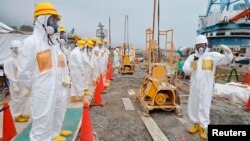The operator of Japan's troubled Fukushima nuclear power plant is coming under fire over contaminated groundwater that has been seeping into the ocean.
The latest problem at the crippled plant involves a rise in ground water as workers have built underground shield walls to prevent contamination from leaking into the ocean. However, the walls built by Tokyo Power and Electric, or TEPCO, have forced water to accumulate and start rising toward the surface.
On Monday, Shinji Kinjo, head of a Nuclear Regulatory Authority (NRA) task force, told Reuters the water is exceeding the legal limits of radioactive discharge and creating an emergency.
Rianne Teule, a nuclear campaigner for Greenpeace International, says the issue is a serious environmental concern.
"Most of all it proves TEPCO is incapable of dealing with this situation and that the Japanese authorities should really step in and ensure that proper action is taken to stop the leaks," said Teule.
But it is not clear what other actions TEPCO could take at this point. Former Nuclear power plant designer Masashi Goto worked on several projects with TEPCO.
"The situation is already beyond what Tepco can handle," said Goto. "If it were possible to take proper measures, they would have done it already right? It's not as if Tepco is refusing to do what they can. They are doing everything they can but there are no perfect solutions."
TEPCO said recently that between 20 to 40 trillion becquerels of radioactive tritium is estimated to have leaked into the ocean since the earthquake and tsunami of 2011. It is the first time the company has acknowledged that contaminated water is leaking into the sea.
Last week, TEPCO General Manager Masayuki said his company is doing everything it can to contain the water.
He said, "We understand that this discharge is beyond our control and we do not think the current situation is good."
A massive earthquake and tsunami in March 2011 shut off the plant's power and cooling systems, causing a meltdown in three nuclear reactors. It was the world's worst nuclear disaster since the 1986 Chernobyl accident in the Soviet Union.
The latest problem at the crippled plant involves a rise in ground water as workers have built underground shield walls to prevent contamination from leaking into the ocean. However, the walls built by Tokyo Power and Electric, or TEPCO, have forced water to accumulate and start rising toward the surface.
On Monday, Shinji Kinjo, head of a Nuclear Regulatory Authority (NRA) task force, told Reuters the water is exceeding the legal limits of radioactive discharge and creating an emergency.
Rianne Teule, a nuclear campaigner for Greenpeace International, says the issue is a serious environmental concern.
"Most of all it proves TEPCO is incapable of dealing with this situation and that the Japanese authorities should really step in and ensure that proper action is taken to stop the leaks," said Teule.
But it is not clear what other actions TEPCO could take at this point. Former Nuclear power plant designer Masashi Goto worked on several projects with TEPCO.
"The situation is already beyond what Tepco can handle," said Goto. "If it were possible to take proper measures, they would have done it already right? It's not as if Tepco is refusing to do what they can. They are doing everything they can but there are no perfect solutions."
TEPCO said recently that between 20 to 40 trillion becquerels of radioactive tritium is estimated to have leaked into the ocean since the earthquake and tsunami of 2011. It is the first time the company has acknowledged that contaminated water is leaking into the sea.
Last week, TEPCO General Manager Masayuki said his company is doing everything it can to contain the water.
He said, "We understand that this discharge is beyond our control and we do not think the current situation is good."
A massive earthquake and tsunami in March 2011 shut off the plant's power and cooling systems, causing a meltdown in three nuclear reactors. It was the world's worst nuclear disaster since the 1986 Chernobyl accident in the Soviet Union.









